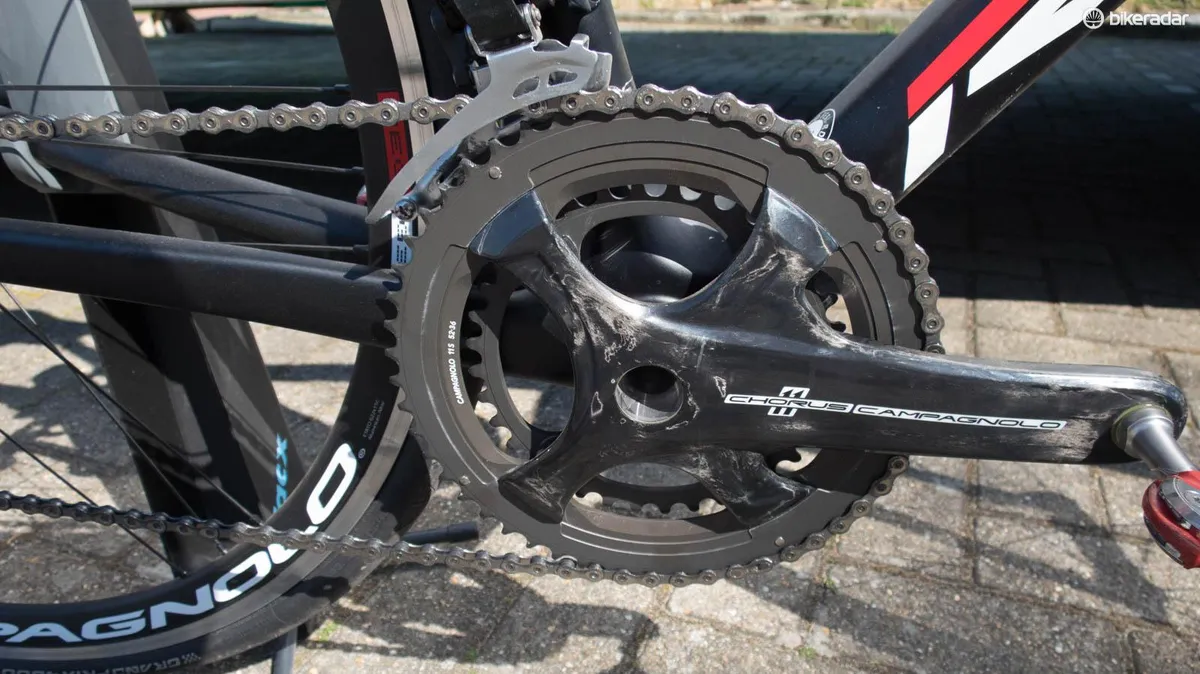Ridley Bikes uses the slogan 'We are Belgium' and indeed, despite the 1997-founded company’s relative youth, its brand is woven into the fabric of the Flandrian cycling scene. As well as having a huge presence in cyclocross, Ridley sponsors WorldTour team Lotto Soudal, and the smaller ProConti outfit CULT Energy.

Our small test bike featured a non-standard Campagnolo Chorus EPS build
Frame and equipment: curvy is the new straight
Like many bike manufacturers, Ridley has divided its road range up to accommodate a variety of tastes. The Noah FAST and Noah SL are pure aero machines, the Helium SL is a lightweight climber’s bike, and the original Fenix Classic was, as the name implies, built for the rough and tumble of Europe’s gruelling spring races. Ridley placed an emphasis on strength and stiffness, and the result was a bike appreciated by the pro-powerhouse likes of Andre Greipel, but which we felt lacked the comfort-oriented features of a machine designed to take on the cobbles.
Ridley obviously thought so too, and so came about the all-new Fenix SL, first spotted by BikeRadar in an anonymous guise at the Scheldeprijs. Even a cursory inspection reveals that this is a quite different design. The top tube now curves downwards slightly, the seatstays have slimmed, and the 31.6mm seatpost (and correspondingly fat seat tube) has shrunk to a more forgiving 27.2mm. In a similar vein, clearances have increased, with Ridley claiming a maximum possible width of 30mm – impressive for a bike with rim brakes. To facilitate this change without compromising on power transfer, the bottom bracket has gone from PF30 to the wider BB86 standard, which makes extra room to add material and boost chainstay stiffness.

The Fenix SL has a BB86 bottom bracket shell in place of its predecessor's PF30 unit
The new Fenix is far from an aero bike, but armed with the experience of the Noah project, Ridley hasn’t neglected aerodynamic considerations entirely, fitting a slim fork that has odd ridges in its legs to act as aerodynamic tripwires. No particular claims were made about the benefits on offer though, so we’re assuming it’s more a case of ‘why not?’. Another feature of the Fenix Classic to have carried over all-but-unchanged is the geometry, which tends towards the large side. (Our small test bike had a 545mm top tube and a 145mm head tube.)
The Fenix SL also retains the distinctive diamond tube profiles of the top tube and down tubes, which Ridley claims offer hugely increased side impact resistance over conventional round ones. For professionals this probably isn’t too important, but from the point of view of an amateur who doesn’t get handed a fresh bike after a crash, this can only be a good thing. The frame is also fully compatible with both mechanical and electronic groupsets, with all cables running internally.

Fully internal cabling keeps things neat
BikeRadar got to ride the Fenix SL in its natural environment back in April; first a short warm-up to tweak position, then a proper outing on the parcours of the Amstel Gold race, which ended up being 105km over rather hilly terrain after navigational incompetence took its toll.
Our test bike was built with a Campagnolo Chorus EPS electronic groupset and Scirocco 35mm wheels from the same stable. We didn’t get a weight on our size small frame, but an identically-specced medium came up at 7.8kg minus pedals – hardly exceptional, but then a good chunk of that is in the rolling stock, which comes from the entry-level end of Campagnolo’s wheel line-up. Our test bike was not a standard option and the range of specs on offer has yet to be confirmed, but from past performance we’re confident Ridley will offer builds to suit a range of budgets, and we confirmed that framesets will also be available.

The Scirocco 35mm wheels are good all-rounders, but on the heavy side
Ride and handling: Solidity all round
On a rolling course with a few quite steep climbs, the Fenix SL proved a capable companion. Power transfer is excellent as is steering precision, and we were happy to attack both climbs and descents with some level of commitment. Our experience with the original Fenix was a bruising one, so assessing the bike’s comfort levels was foremost in our minds during the ride. For what it’s worth, our tester was fitted with 25mm rubber which we made extremely certain wasn’t over-inflated, and the seatpost was a carbon unit with a good deal of flex.

The 27.2mm carbon post provided a decent degree of flex
Nevertheless, the ride quality still erred towards the firm, with unanticipated potholes issuing sharp reminders of the need for vigilance. It’s not an unpleasant ride by any stretch; the feeling of directness gives the bike a raw quality that’s quite rewarding when the urge to push hard takes you, but riders in parts of the world with less well-kept road surfaces are likely to want to take fuller advantage of the tyre clearances on offer.
Is the Fenix SL an improvement on its predecessor? It is, but don’t be mistaking it for a cosseting cruiser – it’s still a firm ride, one that lighter riders may still find unforgiving, and one in which rouleurs will revel.
Update: The Fenix SL will be available in specs ranging from the 105-equipped SL 50 (€1,999) through to the top-end Dura-Ace-based SL 10 (€5,899). See www.ridley-bikes.com.

















